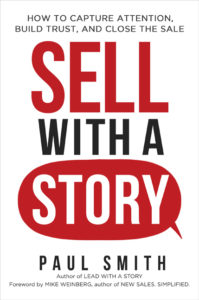Podcast: Play in new window | Download | Embed
Subscribe: RSS
Podcast (lead-with-a-story-podcast-series): Play in new window | Download | Embed
Subscribe: RSS

Which of the following do you think would work better?
Imagine you’re an executive at a large, multi-national company. You have a crop of 25 newly hired research analysts in a large conference room waiting for some wisdom and inspiration from you, the boss, on their first day on the job.
You have one piece of advice to impart that you think will make the biggest difference in their ultimate success or failure in their first two years. Among your other welcoming remarks, you share the following:
Option 1:
“I’ve been in this business for 25 years. I’ve seen good research and I’ve seen bad research. I’ve seen good analysts come here and do well, and I’ve seen poor ones leave before the end of their first year. I’d love to see all of you succeed here well enough to take my job someday. So let me just cut to the chase. If there’s one thing I could share with you that will make the biggest difference early in your career it’s this – make sure you’re clear on your objectives before you start your research project, not after. If you wait till after, you may be sorely disappointed in the result.”
“Not bad,” you think to yourself. “Clear. Succinct. Genuine. Caring.” And you’d be right. But how effective was it? To find out, ask yourself this. If you were one of the new hires, how would you respond to being told that you should get clear on your objectives before you start your research project? You’d probably find that to be a blinding glimpse of the obvious, and therefore perhaps a bit insulting. After all, nobody thinks it’s important to be unclear on their objectives before starting a project. Chances are, that advice will go in one ear and out the other.
Now, consider this alternative from Jayson Zoller, V.P. of market research at Kao Corporation.
Option 2:
When Jayson was a college student, one of his favorite professors told the class a story so compelling Jayson is still retelling it two decades later. Apparently the professor’s students from a previous class had an unusual project working for a local district judge. The assignment: Investigate the jury deliberation process and determine how to improve it. As young, idealistic college students, the team was excited to tackle such a noble mission.
The students interviewed dozens of judges, attorneys, former jurors, and other court officials around the district. They asked all the questions you probably would have asked if you’d been on the team. How many men were in the jury versus women? What was the mix of ethnic backgrounds? How many older jurors were there versus younger ones? Were there differences in the instructions given the jurors, or what kind of information they were allowed to have in the jury room? Did the trials last days, weeks, or months? They even asked how late the jurors were made to work into the evening and what kind of food they were fed.
 To their surprise, none of those things seemed to matter much. What did matter, it turned out, was the shape of the table in the jury room! In courtrooms where there was a rectangular table, the juror sitting at the head of the table (even if that person wasn’t the jury foreman) tended to dominate the conversation. This kept some jurors from sharing their points of view as openly. But, in jury rooms that had a round or oval table, the jurors tended to be more egalitarian and their debate of the facts was more thorough and robust. The team concluded it was those juries with round tables that came to the most accurate and just verdicts.
To their surprise, none of those things seemed to matter much. What did matter, it turned out, was the shape of the table in the jury room! In courtrooms where there was a rectangular table, the juror sitting at the head of the table (even if that person wasn’t the jury foreman) tended to dominate the conversation. This kept some jurors from sharing their points of view as openly. But, in jury rooms that had a round or oval table, the jurors tended to be more egalitarian and their debate of the facts was more thorough and robust. The team concluded it was those juries with round tables that came to the most accurate and just verdicts.
They were excited about their finding as they presented the results to the chief judge. The judge was just as excited that’s he’d been given such an easy solution. He immediately issued a decree to all the courthouses in his jurisdiction. Effective immediately, “All jury rooms that have round and oval tables, get rid of them. Replace them with rectangular tables.”
Read those last two sentences again. That wasn’t a typo. In direct contradiction to their recommendation, the judge removed all the round and oval tables and put in rectangular tables. Why? Because the judge’s objective in improving the jury deliberation process wasn’t to make it more robust, fair, or even accurate. It was to make it faster. He wanted to reduce the backlog on his court docket.
The students were mortified. They thought they were single-handedly fixing the sometimes-brutal consequences of an imperfect judicial system. Instead, they were unwittingly responsible for making it, in their eyes, a little bit less perfect. They may have finished the year with an A on their report card, but they felt completely defeated. In fact, if they’d known ahead of time what the real objective was, they might never have accepted the assignment in the first place.
Twenty years later, Jayson tells this story to new researchers to teach them the importance of being clear on objectives before they embark on a research project. Instead, he could simply tell them some version of Option 1 above. But that wouldn’t be nearly as effective, would it? By telling a story, Jayson lets his audience learn a lesson almost firsthand and experience what it would feel like to not be clear on objectives up front — and suffer the consequences.
Experience is the best teacher. A compelling story is a close second. Everything else is a distant third.
Learning how to find, craft, and deliver a compelling leadership story is probably the most important leadership skill you’ve never tried with any seriousness to learn. If you’d like to learn how, it’s one of the many critical skills you can learn November 10-11 at Executive Insight 16 in New York.
[You can find this and over 100 other inspiring leadership stories in my book, Lead with a Story.]
—
 Paul Smith is one of the world’s leading experts on business storytelling. He’s a keynote speaker, storytelling coach, and bestselling author of the books Lead with a Story, Parenting with a Story, and Sell with a Story.
Paul Smith is one of the world’s leading experts on business storytelling. He’s a keynote speaker, storytelling coach, and bestselling author of the books Lead with a Story, Parenting with a Story, and Sell with a Story.


 Connect with him via email here.
Connect with him via email here.
Follow him on Facebook, LinkedIn, Twitter, and Instagram.
Sign up for his newsletter here to get one new story a week delivered to your inbox.

